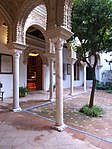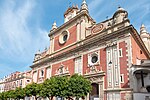Real Academia de Bellas Artes de Santa Isabel de Hungría
Art museums and galleries in SpainDecorative arts museums in SpainMuseums in SevilleOrganisations based in Spain with royal patronageSpanish museum stubs

The Real Academia de Bellas Artes de Santa Isabel de Hungría (Royal Academy of Fine Arts of Saint Isabel of Hungary) is located in the Casa-Palacio de los Pinelo in central Seville, Spain. It is divided into six sections: Architecture, Sculpture, Painting, Music, Archaeology, Decorative Arts and Performing and Audiovisual Arts. It was founded in 1660. Notable members include; Ana María Vicent Zaragoza, José Hernández and Pepi Sánchez.
Excerpt from the Wikipedia article Real Academia de Bellas Artes de Santa Isabel de Hungría (License: CC BY-SA 3.0, Authors, Images).Real Academia de Bellas Artes de Santa Isabel de Hungría
Calle Abades, Seville Casco Antiguo
Geographical coordinates (GPS) Address Website Nearby Places Show on map
Geographical coordinates (GPS)
| Latitude | Longitude |
|---|---|
| N 37.3877 ° | E -5.9911 ° |
Address
Casa de los Pinelo
Calle Abades
41004 Seville, Casco Antiguo
Andalusia, Spain
Open on Google Maps











